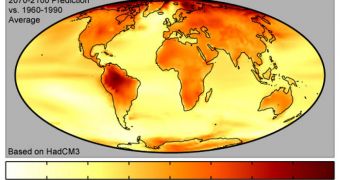According to a new scientific investigation, it would appear that global warming will continue to increase mean temperatures on Earth throughout this century. However, the study also indicates that the effect may stall at times, influenced by the deep ocean and other factors.
Investigators determined that temperature rises may simply stall at times, sometimes for as much as a decade. After the period passes, the temperatures will continue to increase at the same pace as before.
This sort of behavior will likely encourage global warming skeptics in their rebuttal of the well-established and verified theory, but climate scientists say that this will not sway their attention from the huge problem at hand.
The researchers behind the new work explain that the extra heat accumulated during the years of stalled global warming will go into the deep ocean, warming it up even more, and causing a host of negative side-effects on marine life and ecosystems.
Experts with the US National Center for Atmospheric Research (NCAR), in Boulder, Colorado, say that they've ran five separate computer simulations of the intricate links that govern the relationships formed between oceans, sea ice, land masses and the atmosphere.
Their results revealed that average global temperatures will rise over the course of the 21st century, but also revealed periods of hiatus, during which oceans will store the extra heat. Several hiatus periods will occur, some short, and others lasting for years.
“We will see global warming go through hiatus periods in the future. However, these periods would likely last only about a decade or so, and warming would then resume. This study illustrates one reason why global temperatures do not simply rise in a straight line,” Gerald Meehl explains.
The expert, who was the lead author of the new study, is a research scientist at NCAR. He explains that, during the hiatuses, the portion of the ocean below 333 meters (1,000 feet) will warm by 19 percent above current levels, LiveScience reports.
Interestingly, the simulations also indicated that the waters above this line will heat at a considerably lower rate, storing a lot less heat than the deeps will. “This study suggests the missing energy has indeed been buried in the ocean,” Kevin Trenberth explains.
“The heat has not disappeared and so it cannot be ignored. It must have consequences,” concludes the investigator, an NCAR researcher and author of the study. The work is detailed in the September 18 issue of the top scientific journal Nature Climate Change.

 14 DAY TRIAL //
14 DAY TRIAL //